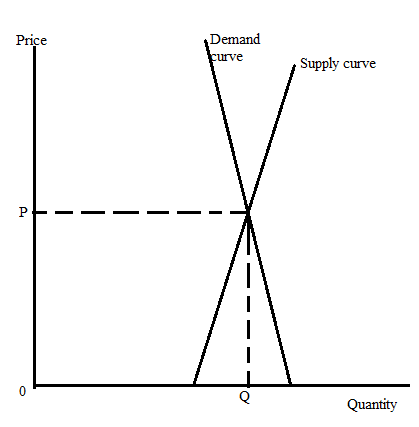
The
Explanation of Solution
If the market in kidneys were legal, then the demand and supply curves look like the ones shown in the diagram.
The demand and supply for the kidney are relatively inelastic because this is the organ that a person needs in emergency situations despite its high cost. The demand for human organs is inelastic in nature.
If the market of kidneys is legal, then the person who needs the kidney would get them despite fluctuating prices.
The demand and supply mechanism keeps the market for the kidney in equilibrium.

If the law that prohibits the sale of kidneys exists in a market, the demand for kidneys will still remain the same. But since the supply is restricted, now a person can only donate the organ instead of selling them.
Suppose in the presence of a law that prohibits the selling of organs, X quantity of kidney is donated by peoples.
Since selling is prohibited, the supply curve is a vertical line parallel to the y-axis because supply is limited and cannot increase according to the market demand.
This explanation is shown in the graph, where the x-axis represents the quantity of the kidney and the y-axis represents the price for the kidney.

The ban or prohibition on the sale of human organs promotes barter exchange, other illegal activities and the black market in organ transfers.
Want to see more full solutions like this?
- 3rd party payments often cause the cost of health care to go down does third party payments to cover medical costs bring the price of medical services up?arrow_forwardApply the concept of equilibrium in the health market or medicine practicearrow_forwardHow does the pricing of "free" health care in Canada affect the quantity consumed?arrow_forward
- What would happen if, in order to provide lower cost health care, the government decided to set a price ceiling (Pmax) in the health insurance market? (Please answer questions a, b, and c below.) What is the effect of this maximum price legislation on the market for health insurance? Briefly explain the situation for both consumers and producers (i.e. health care providers). What might the government do to achieve their intended aims (i.e. lower costs and increased quantity)?arrow_forwardIf you could create the best transplant system for a country, what regulations would you create to manage the cost and benefits of transplants? answer in three paragrapharrow_forwardWhat is the relationship between health and health economics?arrow_forward
- Suppose the government imposes a system of price ceilings in the health care industry as part of an overall health care reform bill. a) draw a graph of the health care market and show equilibrium price and quantity. b) assume the government imposes an effective price ceiling in the health care market. Show the price ceiling in your graph. Indicate what will happen to quantity demanded and quantity supplied of health over time ? c) would a shortage or surplus result ? I llustrate in your graph.arrow_forwardHow should individuals in society respond to government-imposed vaccinations?arrow_forwardDiscuss the kind of pressure the Health Maintenance Organizations (HMO) exerted on the price of drugs.arrow_forward
 Exploring EconomicsEconomicsISBN:9781544336329Author:Robert L. SextonPublisher:SAGE Publications, Inc
Exploring EconomicsEconomicsISBN:9781544336329Author:Robert L. SextonPublisher:SAGE Publications, Inc
 Microeconomics: Private and Public Choice (MindTa...EconomicsISBN:9781305506893Author:James D. Gwartney, Richard L. Stroup, Russell S. Sobel, David A. MacphersonPublisher:Cengage Learning
Microeconomics: Private and Public Choice (MindTa...EconomicsISBN:9781305506893Author:James D. Gwartney, Richard L. Stroup, Russell S. Sobel, David A. MacphersonPublisher:Cengage Learning Economics: Private and Public Choice (MindTap Cou...EconomicsISBN:9781305506725Author:James D. Gwartney, Richard L. Stroup, Russell S. Sobel, David A. MacphersonPublisher:Cengage Learning
Economics: Private and Public Choice (MindTap Cou...EconomicsISBN:9781305506725Author:James D. Gwartney, Richard L. Stroup, Russell S. Sobel, David A. MacphersonPublisher:Cengage Learning





